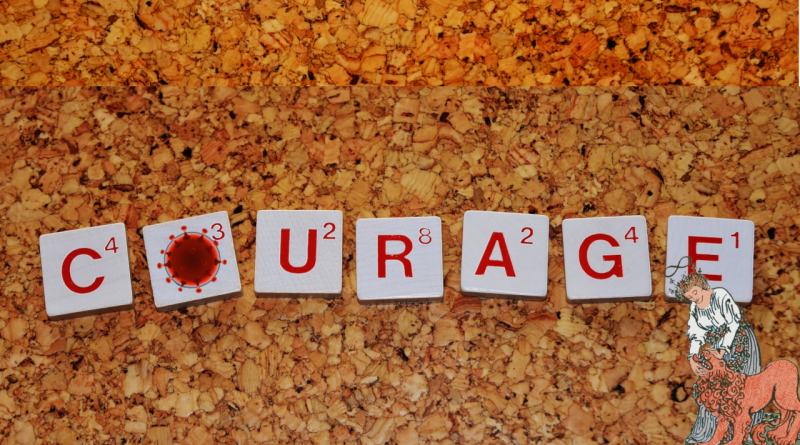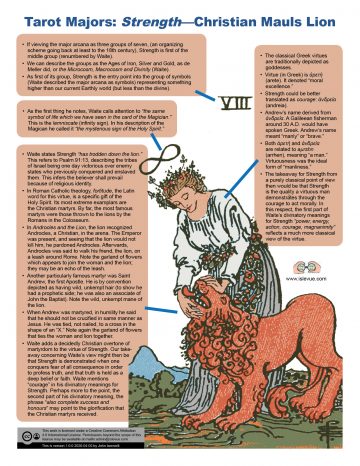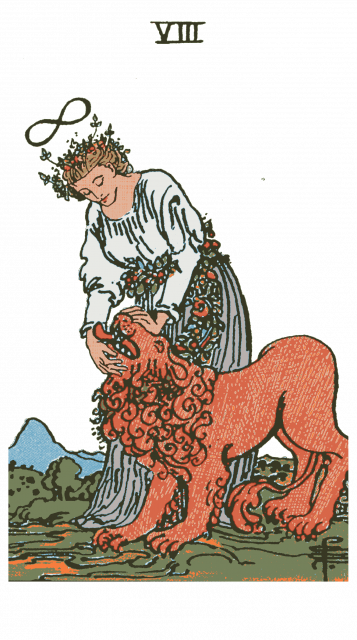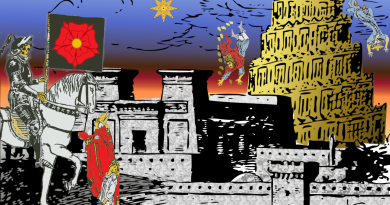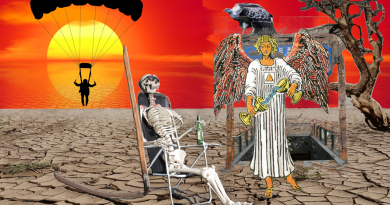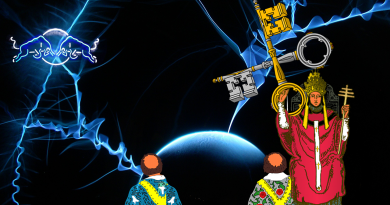Strength – Christian Mauls Lion
The classical idea of the virtue of Strength has little to do with physical strength. It involves a physical or metaphysical confrontation with a threat that must be overcome, or through perseverance, survived. Waite, in his Strength major arcanum, adds another element: the Holy Spirit. There was historical precedent, for the Roman Catholic Church had already linked the two. Waite’s chief graphical element making the link is the lemniscate, otherwise known as the infinity sign. A number of visual references additionally may tie Strength to various Christian martyrs, Saint Andrew in particular, and of course, to Androcles and his friend, the lion.
The post continues a format—one page, one basic thought—depicting a single aspect of a major arcanum. So much has already been written about each of the major arcana, I see no need to repeat the general literature.
The format centers around a graphic, usually featuring the card itself, that sheds light on a single factor that helps make that arcanum what it is, along with (hopefully) a brief amount of text. Note the higher quality PDF download will be easier to read. Much of the text in the main section below repeats the text in the PDF, though this post includes quite a bit of material not present in the PDF.
Christian Mauls Lion
The classical idea of the virtue of Strength (or Fortitude as Waite seems to have preferred, or Courage, which might be an even better translation) has little to do with physical strength. As first described by Plato and Aristotle, and later described by Wikipedia, it is about:
forbearance, strength, endurance, and the ability to confront fear, uncertainty, and intimidation.
Strength therefore involves some sort of physical or metaphysical confrontation. Some threat must be overcome or through perseverance, survived. In fact, when we consider the first clause in Waite’s divinatory meaning for Strength—”power, energy, action, courage, magnanimity”—we can easily trace the source of those qualities to the classical virtue of Strength. All or some of those qualities help us to confront the threat.
Waite, as we shall see, adds another element: the Holy Spirit. He does this via both his words (in the Pictorial Key to the Tarot) and via Colman Smith’s graphic, which he no doubt supervised closely. It is certainly another case in which we see Waite’s Christian mysticism influencing the Waite-Smith tarot. It’s not a completely gratuitous influence, however, as the Roman Catholic Church adopted the four classical virtues (Strength, Justice, Prudence, Temperance) and added three theological virtues of its own (Faith, Hope and Charity) to make the seven virtues cerca 500 A.D. The modern tarot includes three of the four classical virtues. During the early stages of tarot’s development, however, when the major arcana were in flux, different combinations of the virtues may have been present. In the Florentine Minchiate deck, which had forty major arcana, we see all seven virtues.
Waite stated “the true Tarot is symbolism; it speaks no other language and offers no other signs.” This is particularly true of the major arcana. Waite uses the word “symbol” thirty three times just in the chapter describing each of the trumps (Part 2, Section 2, “The Trumps Major and Their Inner Symbolism.” Therefore, we shall trace Waite’s connections between Strength and the Holy Spirit by symbol:
Strength: Visual Elements
The Roman Numeral VIII
- If viewing the major arcana as three groups of seven, (an organizing scheme going back at least to the 18th century), Strength is first of the middle group (renumbered by Waite).
- We can describe the groups as the Ages of Iron, Silver and Gold, as Court de Gébelin‘s associate, de Mellet did, or the Microcosm, Macrocosm and Divinity (Waite).
- As first of its group, Strength is the entry point into the group of symbols (Waite described the major arcana as symbols) representing something higher than our current Earthly world (but less than the divine).
The Lemniscate
- As the first thing he notes, Waite calls attention to “the same symbol of life which we have seen in the card of the Magician.” This is the lemniscate (infinity sign). In his description of the Magican he called it “the mysterious sign of the Holy Spirit.”
The Lion
- Waite states Strength “has trodden down the lion.” This refers to Psalm 91:13, describing the tribes of Israel being one day victorious over enemy states who previously conquered and enslaved them. This infers the believer shall prevail because of religious identity.
- In Roman Catholic theology, fortitude, the Latin word for this virtue, is a specific gift of the Holy Spirit. Its most extreme examplars are the Christian martyrs. By far, the most famous martyrs were those thrown to the lions by the Romans in the Colosseum.
- In Androcles and the Lion, the lion recognized Androcles, a Christian, in the arena. The Emperor was present, and seeing that the lion would not kill him, he pardoned Androcles. Afterwards, Androcles was said to walk his friend, the lion, on a leash around Rome. Note the garland of flowers which appears to join the woman and the lion; they may be an echo of the leash.
- Another particularly famous martyr was Saint Andrew, the first Apostle. He is by convention depicted as having wild, unkempt hair (to show he had a prophetic side; he was also an associate of John the Baptist). Note the wild, unkempt mane of the lion.
- When Andrew was martyred, in humility he said that he should not be crucified in same manner as Jesus. He was tied, not nailed, to a cross in the shape of an “X.” Note again the garland of flowers that ties the woman and lion together.
- Waite adds a decidedly Christian overtone of martyrdom to the virtue of Strength. Our take-away concerning Waite’s view might then be that Strength is demonstrated when one conquers fear of all consequence in order to profess truth, and that truth is held as a deep belief or faith. Waite mentions “courage” in his divinatory meanings for Strength. Perhaps more to the point, the second part of his divinatory meaning, the phrase “also complete success and honours” may point to the glorification that the Christian martyrs received.
-
There is another pair of “footnotes” that have to do with Saint Andrew, Strength and Chastity, though I thought them too tentative to place in the PDF graphic. We’ll describe them here for anyone interested; perhaps somone else can make something of it. First, in the description of Strength, Waite uses a curious phrase which shouldn’t have anything to do with Strength: “innocentia inviolata.” This may possibly be related to one of the better known Gregorian Chants called the Inviolata which includes the line “Our hearts and tongues now ask of thee/that our souls and bodies may be pure.” It may be possible that the very prominent tongue of the lion in Colman Smith’s illustration is meant to recall this! In the same vein as the Chastity reference, Wikipedia notes that “In the Western Esoteric tradition, Andrew is associated with the astrological sign of Virgo.” Our virtuous goddess (see below) walking her lion is truly virtuous! Purity/chastity and Virgo would be far more appropriate for the Hermit; but recall that Waite rearranged the order of the major arcana to put Strength before the Hermit. Strength, of course, falls under Leo. Secondly, given that Andrew is the patron saint of Scotland, it may also be possible that Waite’s reference (also in his description of Strength) to “the Divine Mystery of Union,” which theologically would refer to the Trinity, may also be a reference to the United Kingdoms of England, Scotland and Wales! This could be a hidden infusion of the British nationalism Waite employed to help increase the popularity of his deck. But perhaps even odder, England also links to the Gregorian chants and Andrew, making a full circle! Pope Gregory I, having seen English slaves in the Roman forum, expressly sent a mission to England which included Augustine of Canterbury, prior of St Andrews.
The Female Figure
- The classical Greek virtues are traditionally depicted as goddesses.
- Virtue (in Greek) is ἀρετή (arete). It denoted “moral excellence.”
- Strength could be better translated as courage: ἀνδρεία (andreia).
- Andrew’s name derived from ἀνδρεία. A Galileean fisherman around 30 A.D. would have spoken Greek. Andrew’s name meant “manly” or “brave.”
- Both ἀρετή and ἀνδρεία are related to aµrshn (arrhen), meaning “a man.” Virtuousness was the ideal form of “manliness.”
- The takeaway for Strength from a purely classical point of view then would be that Strength is the quality a virtuous man demonstrates through the courage to act morally. In this respect, the first part of Waite’s divinatory meanings for Strength “power, energy, action, courage, magnanimity” reflects a much more classical view of the virtue.
Strength and the Present Day
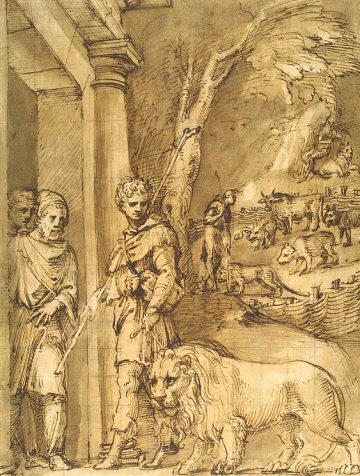
I’m not sure that I’ve ever seen a reading in which the second phrase in Waite’s divinatory meanings, “complete success and honors” had much relevance. Perhaps it may be a measure of the diminished role organized religion occupies in my particular part of the world. Like much of Waite’s Christian symbolism, it has been submerged. I sometimes think that if all those people who say tarot is the work of the devil had any idea of how much mystical Christianity Waite hid in his deck, churches would offer Wednesday Bingo and Thursday Tarot readings.
As I write, much of the world is doing its best to deal with a pandemic. There is widespread fear and most people, including me, do not leave their homes unless absolutely necessary (I live in a state under a “lockdown” order). No one knows how widespread or dangerous the threat is because the corruption of our institutions—government, media, commerce, religion—has become so critical during the past forty or fifty years that no one can fully believe any public statement.
In that respect, the “spin” that Waite adds to the classical virtue, that of overcoming and persevering based upon the strength of deeply held moral belief (or faith) may be appropriate for our own time of the plague. Such belief does not have to be religious. Just knowing right from wrong is probably enough to “persevere” and do the right thing no matter what the cost. Nurses and doctors treat patients even if personal protective equipment is in short supply because helping patients is their deepest belief. Making a grocery run for a neighbor who is temporarily unemployed, when you’re also temporarily unemployed is also a form of Strength. Some of us may not survive, but I hope that we put up a strong fight. Maybe Strength is a good starting place.
On a final, personal note, I seem to have passed through my encounter with CV19. I had a very slight fever one night, dry throat a few days, body ache and general feeling of less-than-well-being (and perhaps some related crabbiness) for about five days. It’s been over a week since then, so presumably I cannot infect others now. Unfortunately, with the extreme (and seemingly deliberate) lack of testing in Florida and the whole U.S., who can be sure? Given the untrustworthiness of most, if not all, U.S. institutions, it could be a positive help to all for as many people as possible who directly experience the virus to relate their experiences. Without testing on the scale of, say, South Korea, whatever statistical analyses, opinion articles and professional/governmental statements Facebook or Reddit or other social media users link to can only be directional at best, self-serving at worst. Personal experiences, though anecdotal, can at least provide a glimpse into the interaction between CV19 and our species.
Copyright Information: This article’s content by John Iacovelli, for islevue.com is licensed under a Creative Commons Attribution 4.0 International License. Permissions beyond the scope of this license may be available at mailto:admin@islevue.com.
This article’s content by John Iacovelli, for islevue.com is licensed under a Creative Commons Attribution 4.0 International License. Permissions beyond the scope of this license may be available at mailto:admin@islevue.com.
The Wikipedia articles’ copyrights are governed by the Creative Commons share-alike license.
Feature image background by Alexas_Fotos from Pixabay
